Abstract
The neplanocin A analogs, 3-deazaneplanocin A, 9-(trans-2',trans-3'-dihydroxycyclopent-4'-enyl)adenine (DHCA), and 9-(trans-2',trans-3'-dihydroxycyclopent-4'-enyl)-3-deazaadenine (DHCDA), all potent inhibitors of S-adenosylhomocysteine (AdoHcy) hydrolase, were studied for their broad-spectrum antiviral potential. 3-Deazaneplanocin A, DHCA, and DHCDA proved specifically effective against vesicular stomatitis virus, vaccinia virus, parainfluenza virus, reovirus, and rotavirus. Their selectivity was greater than that of neplanocin A, particularly against vesicular stomatitis virus and rotavirus. As could be expected from adenosine analogs that are directly targeted at AdoHcy hydrolase, 3-deazaneplanocin A, DHCA, and DHCDA were fully active in adenosine kinase-deficient cells, implying that their activity did not depend on phosphorylation by adenosine kinase. None of the AdoHcy hydrolase inhibitors showed selective activity against human immunodeficiency virus (type 1). 3-Deazaneplanocin A at a dose of 0.5 mg/kg per day conferred marked protection against a lethal infection of newborn mice with vesicular stomatitis virus.
Full text
PDF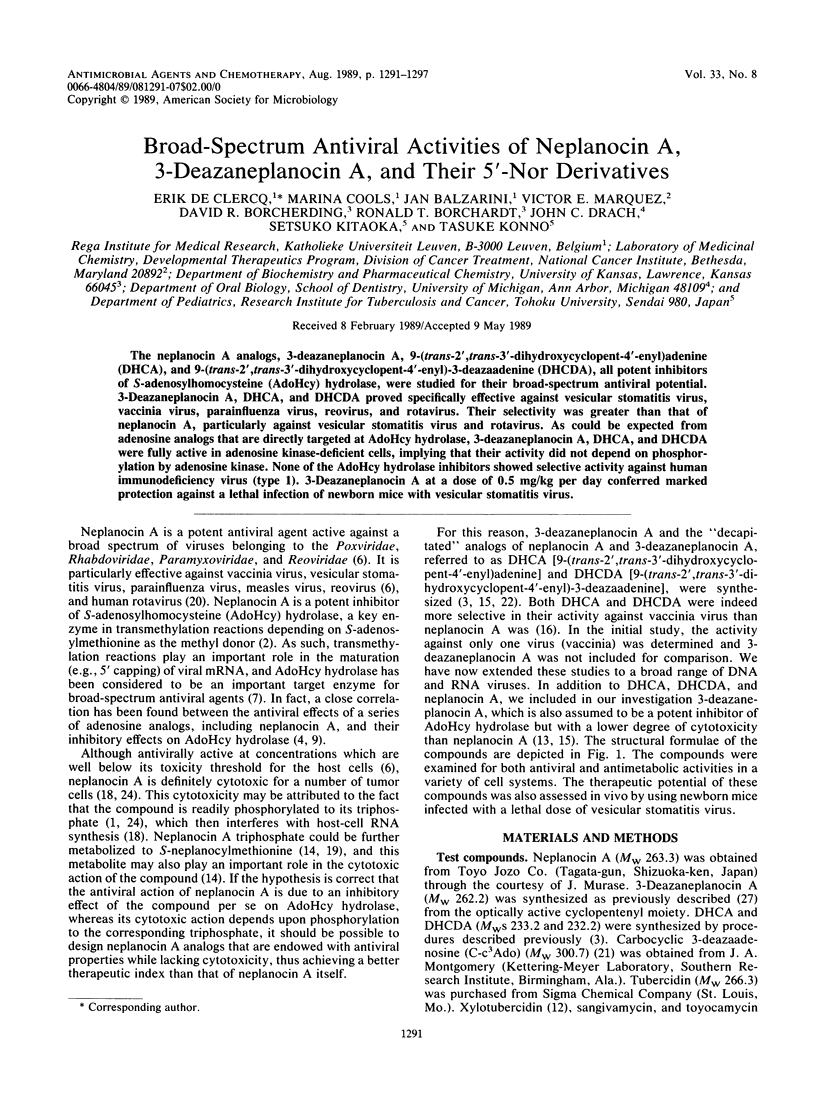
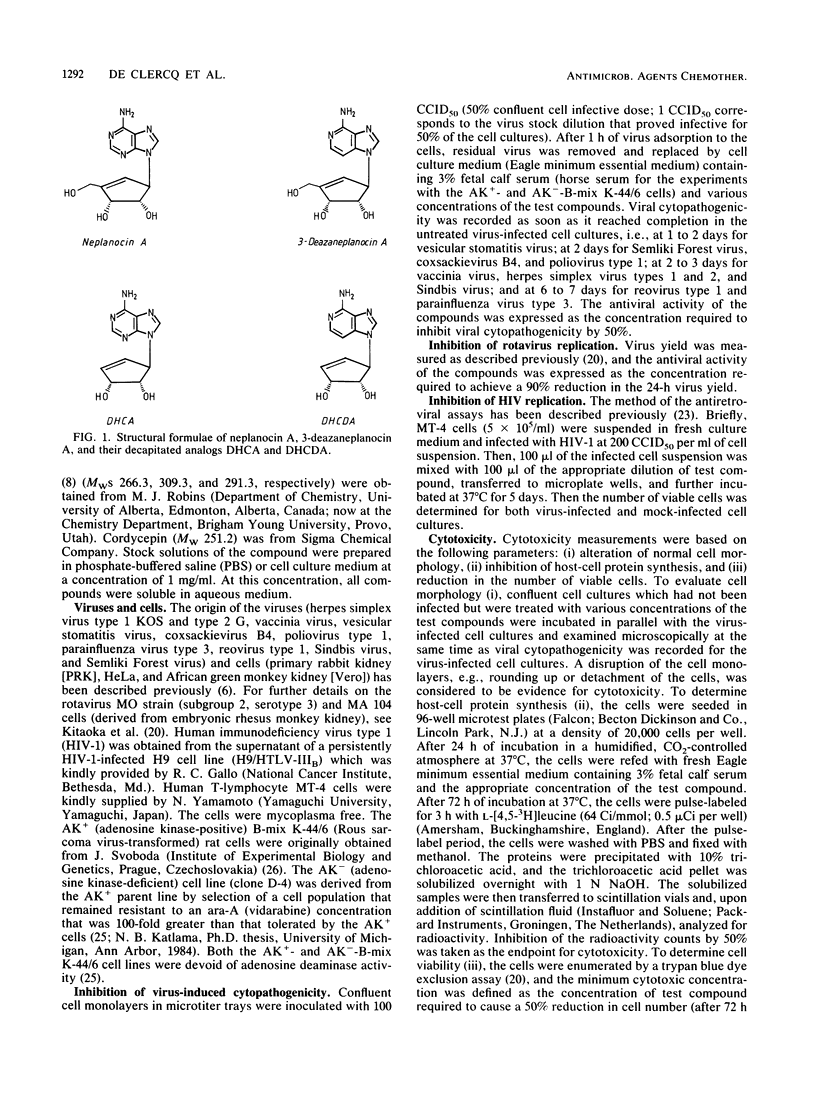

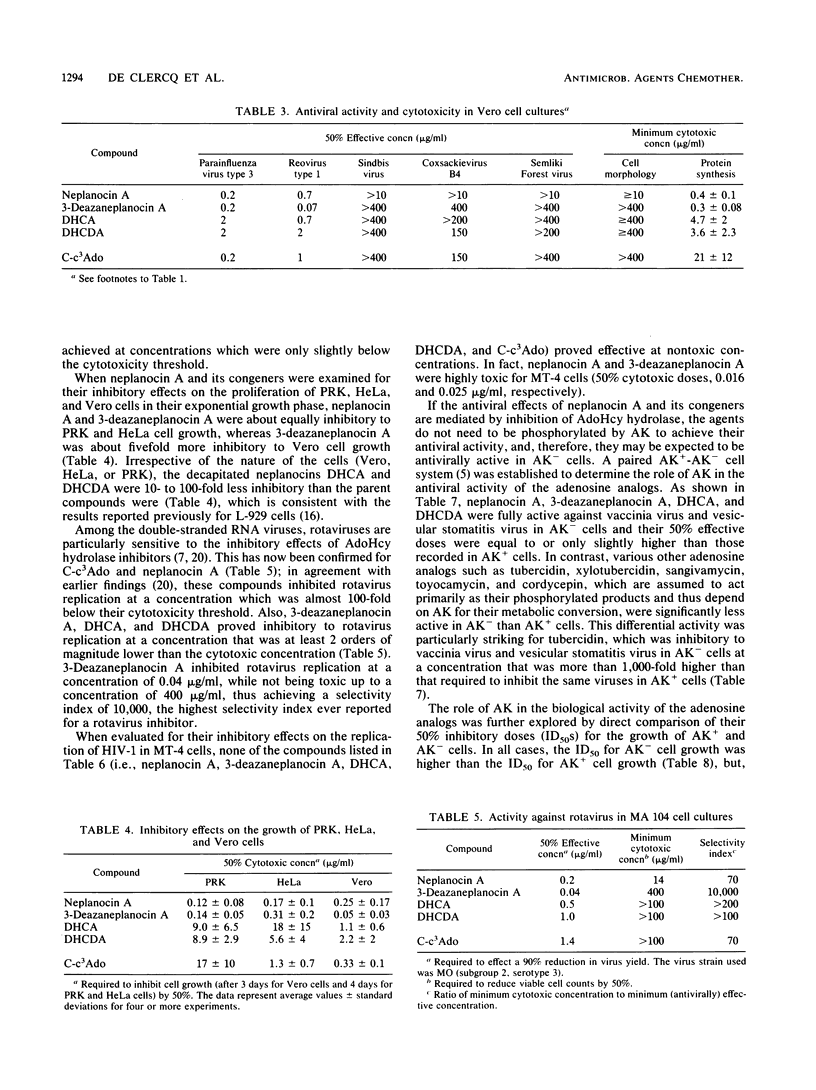
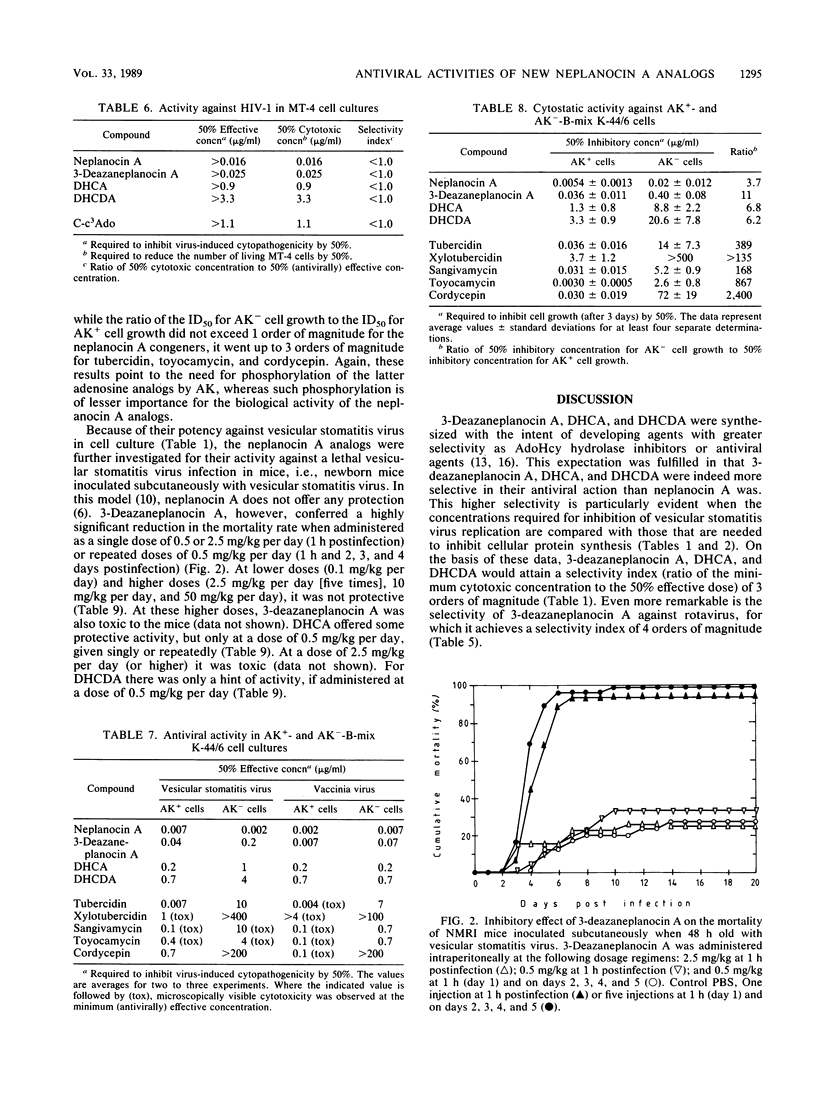
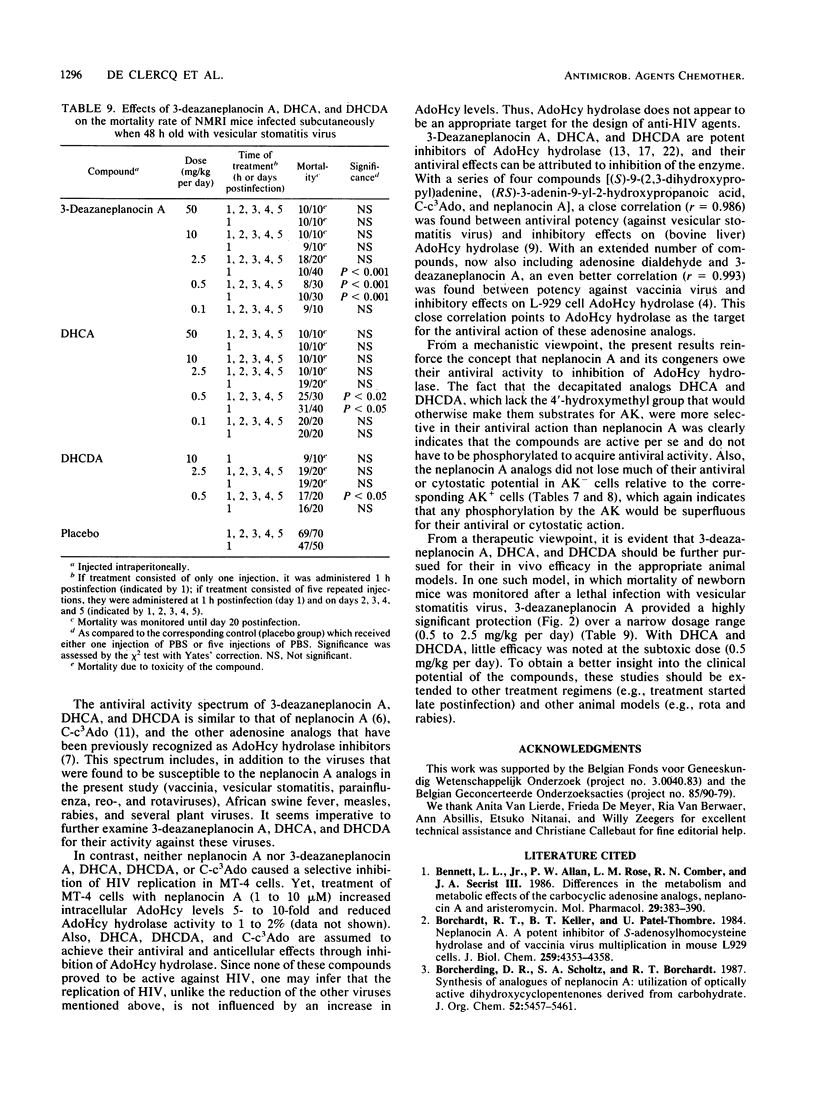

Selected References
These references are in PubMed. This may not be the complete list of references from this article.
- Bennett L. L., Jr, Allan P. W., Rose L. M., Comber R. N., Secrist J. A., 3rd Differences in the metabolism and metabolic effects of the carbocyclic adenosine analogs, neplanocin A and aristeromycin. Mol Pharmacol. 1986 Apr;29(4):383–390. [PubMed] [Google Scholar]
- Borchardt R. T., Keller B. T., Patel-Thombre U. Neplanocin A. A potent inhibitor of S-adenosylhomocysteine hydrolase and of vaccinia virus multiplication in mouse L929 cells. J Biol Chem. 1984 Apr 10;259(7):4353–4358. [PubMed] [Google Scholar]
- Cools M., de Clercq E. Correlation between the antiviral activity of acyclic and carbocyclic adenosine analogues in murine L929 cells and their inhibitory effect on L929 cells S-adenosylhomocysteine hydrolase. Biochem Pharmacol. 1989 Apr 1;38(7):1061–1067. doi: 10.1016/0006-2952(89)90249-9. [DOI] [PubMed] [Google Scholar]
- De Clercq E. Antiviral and antimetabolic activities of neplanocins. Antimicrob Agents Chemother. 1985 Jul;28(1):84–89. doi: 10.1128/aac.28.1.84. [DOI] [PMC free article] [PubMed] [Google Scholar]
- De Clercq E., Balzarini J., Madej D., Hansske F., Robins M. J. Nucleic acid related compounds. 51. Synthesis and biological properties of sugar-modified analogues of the nucleoside antibiotics tubercidin, toyocamycin, sangivamycin, and formycin. J Med Chem. 1987 Mar;30(3):481–486. doi: 10.1021/jm00386a007. [DOI] [PubMed] [Google Scholar]
- De Clercq E., Cools M. Antiviral potency of adenosine analogues: correlation with inhibition of S-adenosylhomocysteine hydrolase. Biochem Biophys Res Commun. 1985 May 31;129(1):306–311. doi: 10.1016/0006-291x(85)91438-x. [DOI] [PubMed] [Google Scholar]
- De Clercq E., De Somer P. Protective effect of interferon and polyacrylic acid in newborn mice infected with a lethal dose of vesicular stomatitis virus. Life Sci. 1968 Sep 1;7(17):925–933. doi: 10.1016/0024-3205(68)90098-2. [DOI] [PubMed] [Google Scholar]
- De Clercq E., Robins M. J. Xylotubercidin against herpes simplex virus type 2 in mice. Antimicrob Agents Chemother. 1986 Nov;30(5):719–724. doi: 10.1128/aac.30.5.719. [DOI] [PMC free article] [PubMed] [Google Scholar]
- De Clercq E. S-adenosylhomocysteine hydrolase inhibitors as broad-spectrum antiviral agents. Biochem Pharmacol. 1987 Aug 15;36(16):2567–2575. doi: 10.1016/0006-2952(87)90533-8. [DOI] [PubMed] [Google Scholar]
- Glazer R. I., Hartman K. D., Knode M. C., Richard M. M., Chiang P. K., Tseng C. K., Marquez V. E. 3-Deazaneplanocin: a new and potent inhibitor of S-adenosylhomocysteine hydrolase and its effects on human promyelocytic leukemia cell line HL-60. Biochem Biophys Res Commun. 1986 Mar 13;135(2):688–694. doi: 10.1016/0006-291x(86)90048-3. [DOI] [PubMed] [Google Scholar]
- Glazer R. I., Knode M. C. Neplanocin A. A cyclopentenyl analog of adenosine with specificity for inhibiting RNA methylation. J Biol Chem. 1984 Nov 10;259(21):12964–12969. [PubMed] [Google Scholar]
- Glazer R. I., Knode M. C., Tseng C. K., Haines D. R., Marquez V. E. 3-Deazaneplanocin A: a new inhibitor of S-adenosylhomocysteine synthesis and its effects in human colon carcinoma cells. Biochem Pharmacol. 1986 Dec 15;35(24):4523–4527. doi: 10.1016/0006-2952(86)90774-4. [DOI] [PubMed] [Google Scholar]
- Hasobe M., McKee J. G., Borcherding D. R., Borchardt R. T. 9-(trans-2',trans-3'-Dihydroxycyclopent-4'-enyl)-adenine and -3-deazaadenine: analogs of neplanocin A which retain potent antiviral activity but exhibit reduced cytotoxicity. Antimicrob Agents Chemother. 1987 Nov;31(11):1849–1851. doi: 10.1128/aac.31.11.1849. [DOI] [PMC free article] [PubMed] [Google Scholar]
- Hasobe M., Mckee J. G., Borcherding D. R., Keller B. T., Borchardt R. T. Effects of 9-(trans-2',trans-3'-dihydroxycyclopent-4'-enyl)-adenine and -3-deazaadenine on the metabolism of S-adenosylhomocysteine in mouse L929 cells. Mol Pharmacol. 1988 Jun;33(6):713–720. [PubMed] [Google Scholar]
- Inaba M., Nagashima K., Tsukagoshi S., Sakurai Y. Biochemical mode of cytotoxic action of neplanocin A in L1210 leukemic cells. Cancer Res. 1986 Mar;46(3):1063–1067. [PubMed] [Google Scholar]
- Keller B. T., Clark R. S., Pegg A. E., Borchardt R. T. Purification and characterization of some metabolic effects of S-neplanocylmethionine. Mol Pharmacol. 1985 Oct;28(4):364–370. [PubMed] [Google Scholar]
- Kitaoka S., Konno T., De Clercq E. Comparative efficacy of broad-spectrum antiviral agents as inhibitors of rotavirus replication in vitro. Antiviral Res. 1986 Jan;6(1):57–65. doi: 10.1016/0166-3542(86)90039-2. [DOI] [PubMed] [Google Scholar]
- Montgomery J. A., Clayton S. J., Thomas H. J., Shannon W. M., Arnett G., Bodner A. J., Kion I. K., Cantoni G. L., Chiang P. K. Carbocyclic analogue of 3-deazaadenosine: a novel antiviral agent using S-adenosylhomocysteine hydrolase as a pharmacological target. J Med Chem. 1982 Jun;25(6):626–629. doi: 10.1021/jm00348a004. [DOI] [PubMed] [Google Scholar]
- Narayanan S. R., Keller B. T., Borcherding D. R., Scholtz S. A., Borchardt R. T. 9-(trans-2',trans-3'-dihydroxycyclopent-4'-enyl) derivatives of adenine and 3-deazaadenine: potent inhibitors of bovine liver S-adenosylhomocysteine hydrolase. J Med Chem. 1988 Mar;31(3):500–503. doi: 10.1021/jm00398a002. [DOI] [PubMed] [Google Scholar]
- Pauwels R., De Clercq E., Desmyter J., Balzarini J., Goubau P., Herdewijn P., Vanderhaeghe H., Vandeputte M. Sensitive and rapid assay on MT-4 cells for detection of antiviral compounds against the AIDS virus. J Virol Methods. 1987 Jun;16(3):171–185. doi: 10.1016/0166-0934(87)90002-4. [DOI] [PubMed] [Google Scholar]
- Saunders P. P., Tan M. T., Robins R. K. Metabolism and action of neplanocin A in Chinese hamster ovary cells. Biochem Pharmacol. 1985 Aug 1;34(15):2749–2754. doi: 10.1016/0006-2952(85)90576-3. [DOI] [PubMed] [Google Scholar]
- Shipman C., Jr, Tong S. L., Smith S. H., Katlama N. B., Drach J. C. Establishment of a murine cell line resistant to arabinosyladenine and devoid of adenosine deaminase activity. Antimicrob Agents Chemother. 1983 Dec;24(6):947–949. doi: 10.1128/aac.24.6.947. [DOI] [PMC free article] [PubMed] [Google Scholar]
- Svoboda J., Veselý P., Donner L. Characteristics of highly polyploid clones isolated from lines of RSV-transformed rat cells. Folia Biol (Praha) 1967;13(1):40–43. [PubMed] [Google Scholar]
- de Clercq E., Montgomery J. A. Broad-spectrum antiviral activity of the carbocyclic analog of 3-deazaadenosine. Antiviral Res. 1983 Mar;3(1):17–24. doi: 10.1016/0166-3542(83)90011-6. [DOI] [PubMed] [Google Scholar]


